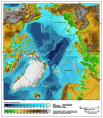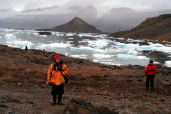Arctic Ocean
Arctic OceanLevel of surfing
Advanced
Quality of surf
Average
Area
45389
Coastline
14,056,000 km
Climate
Polar Maritime
Hazards
Very Isolated, Extreme Cold, Severe Storms
Best Months
November - February
Time Zone
ZULU (UTC) to MIKE/YANKEE (UTC+/-12)
Special Requirements
Special Pass / Permits, Non tourist Friendly
introduction

Mikkalai: IBCAO betamap (Source: www.wikipedia.org); 2 August 2007
The Arctic Ocean is located in the northern hemisphere and mostly in the Arctic north polar region. It is the smallest of the world's five oceans (after the Pacific Ocean, Atlantic Ocean, Indian Ocean, and the recently delimited Southern Ocean). The Northwest Passage (US and Canada) and Northern Sea Route (Norway and Russia) are two important seasonal waterways. A sparse network of air, ocean, river, and land routes circumscribes the Arctic Ocean. It is largely covered by sea ice throughout the year, but its temperature and salinity vary seasonally as the ice cover melts and freezes. The salinity of the Arctic Ocean is the lowest on average of the five major seas, due to low evaporation, heavy freshwater inflow from rivers and streams, and limited connection and outflow to surrounding oceanic waters with higher salinities.
Although recognized as an ocean by the International Hydrographic Organization (IHO), some oceanographers may call it the Arctic Mediterranean Sea or simply the Arctic Sea, classifying it as one of the mediterranean seas of the Atlantic Ocean.
Nearly surrounded by land, its only outlets are the Bering Strait between Alaska and Russia, Davis Strait between Greenland and Canada, and Denmark Strait and the Norwegian Sea between Greenland and Europe. The Arctic Ocean has an area of 14,090,000 sq km and an average depth of 3,658 m off of the continental shelf. The lowest point is Fram Basin which is 4,665 m deep. The Artic Ocean has the widest continental shelf of all the oceans.
surfing

Mila Zinkiva: High Arctic; 2005
The Arctic Ocean is very important to Northern Hemisphere surfers, not so much from the point of view of feasible surf locations but that it is the birthplace of the northerly swells that much of Europe and the West African coast rely upon. The combination of Eurasia, North America and Greenland almost landlock the Arctic, hence when storm systems doe generate within the area they often explode across the Bering Strait or along the Scandanavian Coast into Europe. With no landmass of it's own, the surfinglocations within this Ocean are covered in the descriptions of the countries that surround it. There are a few reefs here though that do not break sea level and hence do not come under any countries juristriction. Extremely dangerous to surf, these waves exist in near freezing temperatures in only the largest storms. Perch yourself on Greenland or remote Canada and wait dear reader if you feel that this is where your destiny lies.






